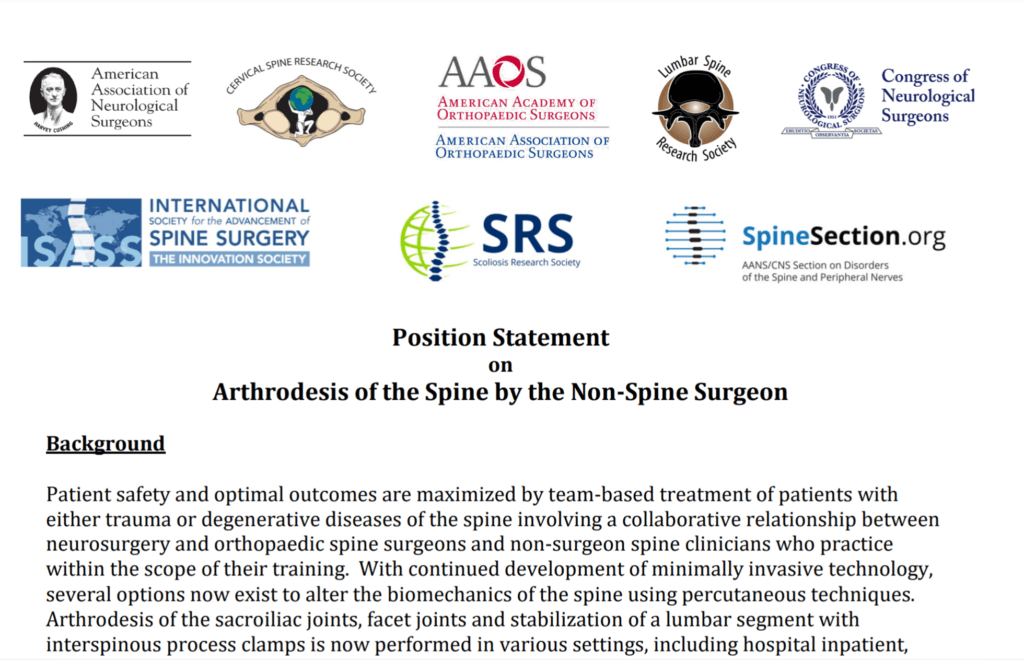The Fusion War

Who should control Spinal Fusion among doctors? There’s an interesting fight going on that’s worth exploring. Let’s dig in.
What Is Fusion?
Spinal surgeons can install hardware and make sure degenerative and painful Spine segments don’t move anymore. This is of course an issue, as it hasn’t been shown to be any better than just removing a bulging disc or some bone. In addition, adding hardware to the Spine increases the risk of the surgery and Adjacent Segment Disease, which you can learn about below:
Interventional Spine Doctors Adding Fusion
Interventional Spine started as a way to help patients avoid surgeries like Fusion. At first, this was the precise injection of steroids or Radiofrequency Ablation. That then morphed into also offering implantable stimulators. Now more recently, Interventional Spine physicians have begun offering Fusion?
Yes, as I’ve blogged before, doctors can now use x-ray guidance (fluoroscopy) to place hardware to fuse the spine. This has led to even more Fusion devices being placed. The problem as I have already written about is that it’s still a Fusion, with all of the warts of the surgery.
Now don’t get me wrong. There are a handful of patients that really need Fusion. The problem is that this is just a tiny fraction of patients who get the surgery.
Why Is This Happening?
Why would doctors who have dedicated themselves to helping patients avoid Spine surgery begin offering Spine surgery? Well, these new Interventional Fusion cases pay very well. Usually a multiple of the most complex Spine injection procedure.
The Fusion War
At the end of last year, a huge number of spinal surgery organizations wrote a letter.Here are a few:
- American Academy of Orthopedic Surgeons
- American Association of Neurologic Surgeons
- International Society for the Advancement of Spine Surgery
- Congress of Neurologic Surgeons
- And a slew of spine research societies
What did they say? Here are a few snippets:
“Optimal patient care and patient safety are best served when surgical diseases affecting the spine are managed by neurosurgeons and orthopaedic spinal surgeons trained in the full spectrum of spinal biomechanics, including instrumentation and fusion techniques. Therefore, arthrodesis or any other intervention that alters the biomechanics of the spine should not be performed by practitioners in other fields outside of specialty-trained neurosurgery or orthopaedic spinal surgeons.”
“Neurosurgeons and orthopaedic spine surgeons can directly address the common potential
complications that arise from instrumentation and/or arthrodesis of the spine.”
So basically Spine surgeons have laid down the gauntlet. Why is this a big deal?
The Problem for Interventionalists Putting in Hardware
What does this mean for an Interventional Spine doctor deciding to put metal into Spines? It’s NOT good. Why should they care?
All interventional procedures carry risk, the good news being that the less invasive, injections procedures carry the least risk, many many times less than surgery. However, once we start increasing the invasiveness of what’s being done by fusing the spine, those risks go way up. So what happens if something goes wrong? The problem, it would seem is that there is now an army of Spine surgeons who are willing to testify in court that you should have never done this procedure because you don’t have adequate training. That generally means that the malpractice risk of performing these procedures just went way up.
The upshot? What will happen with the new Spinal Fusion war? It’s going to be interesting with tens of thousands of doctors all gunning for Spine Interventionists performing Fusion.

NOTE: This blog post provides general information to help the reader better understand regenerative medicine, musculoskeletal health, and related subjects. All content provided in this blog, website, or any linked materials, including text, graphics, images, patient profiles, outcomes, and information, are not intended and should not be considered or used as a substitute for medical advice, diagnosis, or treatment. Please always consult with a professional and certified healthcare provider to discuss if a treatment is right for you.
